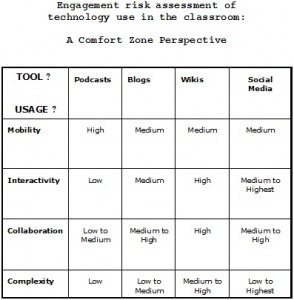Published on
All You’ve Got To Do Is JUMP – Harnessing Risk Taking Behaviors In The Technology Classroom Environment

Two years ago a friend in need of intellectual encouragement and direction called me for help. She was desperate to be talked off the ledge she had been sitting on for quite some time. She wanted me to bring her back into the room. I said, “No.”
The phone got awfully quiet. I heard a sniffle. Then a gulp. “What?” she whispered.
Then I said to her, very lovingly, the following: “When you find yourself out on the ledge, ready to jump, whatever you do—DON’T go back in the room that caused you to get to the ledge. Instead JUMP! Jump hard. Be ready to bounce in directions you didn’t know existed. Not just a reactionary bounce but a huge bounce. One with serious intent. Sure it’s scary and it takes a lot of Moxi and it may leave a mark. But in order to get beyond that room of malcontent and defeat you have to release yourself to potential of something else. If you go back in the room nothing changes. Because that same room will always lead you to the same ledge. I won’t talk you down but I’ll tell you to jump!”
Her breathing slowed. After a bit of a pause she said, “You’re right.”
We talked a bit more. We talked about what that jump might look like. We spoke of the potentially positive, and negative, outcomes of the jump. We dissected the jump a million ways and came to the same conclusion: tuck and jump because anything is better than the misery of the status quo.
So she held her breath, jumped and learned to bounce—high! Her results were good. I learned something that day too: Sometimes I give pretty good advice and I should follow it myself!
I started looking at times when I was out on the ledge and analyzing the instances where I went back in the room hoping for different results. We all know where that leads. Yep, I’d find myself on the same ledge bemoaning my circumstances and wondering why I got there. I may be slow to ‘get it’ sometimes but slowly I realized my own irony and started jumping. A couple of skinned knees later, and some fabulous vista souring bounces, I’m a pro jumper.
Although I think these guys are generally nuts, I like the term Base Jumper. It appeals to me in the sense that they’ve taken a structure, a solid tangible thing, and use it for something entirely different if not a tad dangerous. I can relate to that. Maybe, over the course of the last couple of years, I’ve become a sort of Educational Base Jumper. An interesting, if risky, concept…
So what does an Educational Base Jumper look like? If I look at like-minded peers there are a number of common traits we all share.
- Experienced in a number of fields with core beliefs in human conduct.
- Ability to cross-apply ideas, content, and outcomes.
- Desire to rework systems in order to provide opportunity for growth.
- Invention and interpretation of old tools to be used as new tools.
- Moxie
(Just writing this out I have to admit, I have some pretty amazing friends and colleagues.)
So on to the second part of this article: The risk factor in technology education. Freud believed that a high risk tolerance was simply a death wish. That an individual who participated in high risk endeavors was simply living fast and high with the hope of checking out sooner rather than later. A lot has changed and now risk is seen more as a collective group thing – something used to build solidarity within a group of individuals. Whereas culture was once build around a common enemy or cause that is now often replaced by activities that provide the same rush which then creates the same chemical reaction and, consequently, the same high. This chemical reaction creates a party atmosphere in the brain and proves Van Halen right, “Might as well Jump!”
However, how much risk is too much risk? What would it look like if, as Educational Base Jumpers, we took a collaborative risk in the classroom? What if we jumped?
We are all pretty familiar with the terms Digital Immigrant and Digital Native so I won’t elaborate on their specific traits but I will use the titles for navigation purposes and inter-related significance to each other.
Let’s begin with a basic assignment outline utilizing various technologies in the Immigrant’s classroom:
- Students chose a topic and are assigned to groups of 2 or 3.
- Each group must have one smart phone with data plan.
- Students are to create a blog or wiki with 10 entries over 5 weeks.
- All entries are to be done from class and in their groups.
- Social media is allowed.
- Each group member must bring a ‘tech of choice’ and incorporate it into the blog.
Before you throw this out as absurd, realize that is how the Natives live. This is how they socialize, play, relate, generate ideas, collaborate, and live out their realities. So why aren’t we using these tools in the teacher’s classroom? Why aren’t we teaching the Immigrants to use the tools of the Natives? Why aren’t we working a model into the Immigrant’s behaviors in the same way that the Natives live? The answer, I believe, is the perception of risk on the part of the Immigrants for the perceived benefit of the Natives.
So I’ve created a brief chart on the perceived severity of risk – high; medium; low – from the perception of the Immigrant.

I find it interesting that the institutions of higher learning seem to have the greatest risk perception of purposefully utilizing the tools in the classroom. This leads to the question of why is there a hesitation to implement these tools into the classroom where the Immigrants are being taught to teach the Natives? It appears that the gap between the communication technologies which are under-utilized for content distribution in the classroom and the students of the next generation who are actively engaged in these technologies is growing wider. My research indicates that there is an overwhelming component of hesitation brought alive by the perceived roadblocks associated with risk.
The populations must come to a meeting point and find a common directional outcome if the needs of the Natives are to be met. In order to understand exactly what this means, here is what the Natives expect with regard to their education:
- Choose what kind of education they buy, and what, where and how they learn
- Adaptive, responsive and learner-centered
- Technology and media in the classroom
- Interactivity and a rich and diverse learning environment
- Collaborative learning
- Modular and customizable education
So how is this done? How does the perceived risk of jumping from the ledge into the unknown correspond with meeting the needs of the Immigrant learner in order to adapt and meet the needs of the Native? What are the key elements of increasing digital engagement for Immigrant students?
- Clear expectations
- Clear parameters
- Higher technology function with ease of use execution
- Examples
- Slideshows
- Video creation
- Story Boards
- Wikis/Blogs/Discussion Boards
- Group Projects
Now, by comparison, what are the key elements of sustaining a Native?
- Creativity Reigns Supreme
- High Social Engagement
- Bigger, Faster, Better!
- Individual expression maintained
- Clear Rubric, loosely defined variables
- Examples
- Multi-media presentations as “Book Reports/Reports”
- Vlogs/Blogs instead of journals
- MME’s recognized as socialization opportunities (facilitated)
- Utilization of VR self as reflection of IRL self – incorporate into classroom experience
When both groups are inspected in their current states, and the inter-connectiveness of the Native and Immigrant is fully realized, only then will there be a deliberate and conscious decision by educators to address the needs of the future student. As long as the perceived risk of the big jump into the unknown is allowed to keep us sitting in an anxiety ridden state on our ledge (and eagerly going back into the room from where we came) we will not bounce to new heights and aim for new directions.
So just JUMP! And let’s BOUNCE! Together!
Peace and good choices.
*For those of you wondering how your risk taking personality measures up, I’ve included a Risk Taking Self Assessment Test. Please take a few moments (it says 30, took me 10) and, if comfortable, include your score in your comments. I’d like to generate a follow up article based on your comments. If privacy is a blockage to your comments, feel free to use an alias and no, emails will not be shown.
“All change in history, all advance, comes from nonconformity. If there had been no troublemakers, no dissenters, we should still be living in caves.” ~ Historian A. J. P. Taylor
Author Perspective: Business



